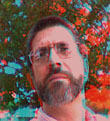Rear screen 3-D projection is not only possible, it is AWESOME! How do I know? I've done it off and on for 25 years.People in the industry natter on about the 3-D "window" but few have ever really seen a true 3-D window in all its glory. Front projecting makes the ideal viewing angle impossible, since the projector has to be close to centered. Problems with light drop off at the edges, specular reflection at the center, etc. make the silver screen less than ideal.
Rear projecting polarized 3-D requires a special plastic material that is fairly expensive, and strange stuff to work with. It does not de-polarize the light as plain frosted plastic or groundglass does, and for some happy reason it doesn't give as much of the usual "hot-spot" where there is a direct alignment through the lens to the projector bulb. The plastic has what appears to be a greenish tint, and is gummy rather than being slick like polyethelene or other plastics. It also acts as a neutral density filter, soaking up some of the light that hits it.
I've done the variations of the virtual reality thing using this plastic and slides, and the plastic and dual super 8 3-D. The slides worked much better, both because of synch problems (arrrgh!!!) and very low light levels from the super eight.
The slides were nothing short of spectacular. I used a section of plastic about a foot on a side, used black matte board as a frame, and projected both prism 3-D and dual projector slides. Because of the small screen, the light levels were very high, and because I am nearsighted, I was able to remove my regular glasses and use the polarizing glasses to get an effect that was as close to looking out a window (with corrected vision) as I've ever seen, including Kodak's 24 image lenticular system.
The effect only works because of the high light levels - giving more realistic contrast levels, the high resolution of color slide film - giving the detail and visual interest that is required for extended 3-D viewing, and the blackout of all extranious distractions.
My best setup was in my basement, where I could baffle the spill light from the projectors and keep any daylight or other light from entering. This made a huge difference compared to when I tried to set up in a dimly lighted room. John's "contrast killers" totally spoil the effect.
The reality was so well recreated that when I had a photo of something that went through the screen plane, it was possible to reach out and expect to touch a solid object. One shot of a horse's nose was particularly effective, with the hair clearly visible. The screen effectively disappeared on many shots, only becoming noticable when there were large areas of solid color and dust.
Trying to do an effective virtual reality with current generation video is, IMO, doomed from the start because the resolution isn't there to carry it off.
I'll tell you what I have done, which is as close as you'll get. There is a $500 3-D alternate scan LCD adapter that can go on the front of most camcorders.
http://www.3-dvideo.com/nuview.html
If you have a 53" or larger rear screen projection TV with a good comb filter (My Hitachi is very good), you can set the zoom on your camcorder to match the screen width. In other words, with the 3-D attachment on the camcorder, sit in your normal viewing position in front of the tv, attach the output from the camcorder to the input of the tv, then zoom in and out until the image of the frame of the picture area exactly matches the actual frame of the set. Rough set the convergence so that the frame of virtual tv set appears superimposed in depth on the actual tv frame.
Precisely adjusting the convergance of the 3-D adapter is next. Use a label to set up markings around the convergance dial. Go outside, set the camera on a tripod, and shoot some shots of an object over 1000 feet away, while adjusting the convergence and announcing the convergance setting.
Play this back on the set, and measure the distance between the two images you see without the LCD shutter glasses. When you get to a setting where the distance is exactly the distance between your eyes, that is _your_ personal perfect setting. It will vary from person to person, set to set, and camera to camera.
Set the convergance to that setting, lock the zoom to the proper setting, and go out shooting scenes using the exact same shooting angle as your viewing angle watching the set. (You'll quickly realize most couches and chairs put your head a little too high when viewing tv.)
When you play back the video tape you shot, you will have achieved as close to 3-D virtual reality with video as you can get with current equipment. It is a far cry from 3-D rear projected slides, but it is quite good, and won't cause much eyestrain.
Eventually, Ultra high definition video and special screens may approach the quality of 3-D rear projected slides, but I don't expect anything like that to hit the market for years.
In case you haven't figured out by now, I am _the_ 3-D nut. 

 Home
Home
 Products
Products
 Store
Store
 Forum
Forum
 Warehouse
Warehouse
 Contact Us
Contact Us




 Printer-friendly view of this topic
Printer-friendly view of this topic














